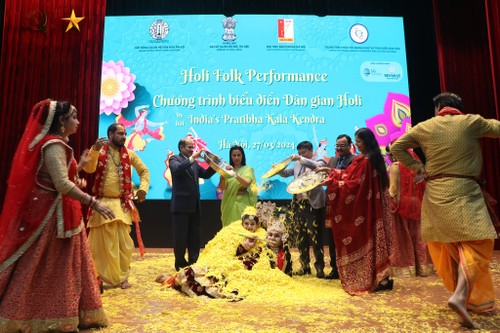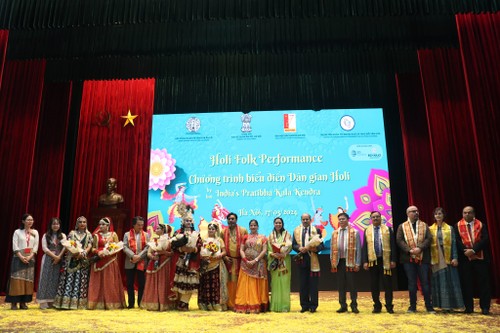The Charkula dance is usually performed by women and is associated with the worship of the Hindu deity Krishna.
At a recent performance in Hanoi by the Pratibha Kala Kendra folk dance group, Indian Ambassador to Vietnam Sandeep Arya said Charkula dance is the dance form of the people.
“It’s a little more popular, it's a little more lyrical, and it’s a bit more rhythmic. The movements are also a little flexible. It's not like a classical dance, which is very strict in terms of the steps that you need to take, and it is not very modern. It represents the way societies have lived for thousands of years, so it’s a very old form, representing the people from the northern part of the country,” said the Indian diplomat.
He noted that there is special clothing, a special way of singing, special dance steps, and so on. It's something that’s very popular among common people, who dance in large groups at the festival.
The Pratibha Kala Kendra group, representing the famous folk-dance tradition of Vrindavan city, will talk about Charkula dancing. The group just concluded a tour of Hanoi, Ha Nam, Thai Nguyen, Lao Cai, and Yen Bai province to introduce Indian folk dance and promote cultural understanding between Vietnam and India.
In the performance of Charkula, veiled women balance a large multi-tiered circular wooden pyramid holding earthen oil lamps on their heads while dancing with swift graceful movements to the tune of the 'Rasiya' songs in praise of Lord Krishna. It’s a challenging test of balance. Sanjay Kumar Sharma, a dancer of the Pratibha Kala Kendra dance troupe, said that their movements are limited because of the heavy load on their head. The dancer cannot bend her body nor move her neck.
It’s basically a dance with a main dancer at the center and is danced in darkness so that the dancer is not clearly visible, but the moving lamps are visible. It’s a fascinating experience to watch Charkula in its native atmosphere.
Sanjay Kumar Sharma said, “Actually, the special thing about the Charkula dance is that we can do it with fireworks. Naturally, it’s difficult to do on a stage inside an auditorium. So here we’re not performing that one. The Charkula we will present here is basically to spread happiness after the birth of a girl child, because we feel that a girl child is a blessing from the mother goddess.”
 (Photo: Embassy of India) (Photo: Embassy of India)
|
The Charkula is performed on the third day after the Holi, a Hindu festival which marks the start of spring in India. It’s believed that Radha, the beloved of the god Krishna, was born on this day. There are various versions of how the dance was shaped.
According to a famous legend, Radha's grandmother ran out of the house, keeping the Charkula on her head to announce the birth of Radha. Since then, Charkula has formed as a popular dance of Brajbhoomi and is performed during various festivals.
But there is another myth related to the dance form. It is believed that the Charkula dance celebrates the happy victory over Lord Indra by Krishna and the cowherd community of Braj. This dance is considered to be a symbol of happiness and joyful rapture.
Whatever is the dance originated, the Charkula is one of the most magnificent dance performances among the Indian tribal dances.
Pratibha Sharma, the troupe’s choreographer and artistic director, said that after getting training from her father, she realized that she should spread the beautiful art form to all over the world.
“That’s why I’m here to spread the culture of India. We, Pratibha Kala Kendra group, use folk dances of the Braj region of India to promote the cultural friendship of India and other countries including Vietnam,” said Pratibha Sharma.
 (Photo: Embassy of India) (Photo: Embassy of India)
|
The Pratibha Kala Kendra folk dance group came to Vietnam once before, in 2007, to perform in HCMC and nearby localities under a cultural exchange program. Late last month, the troupe concluded their performance tour of Hanoi, the Tam Chuc tourism complex in Ha Nam province, the Vietnam-India Secondary School and Thai Nguyen University in Thai Nguyen province, Lao Cai, and Yen Bai province.
In addition to dance performances, a number of exchange activities and seminars were held to give Vietnamese audiences a better understanding of the history and characteristics of Indian folk dances.